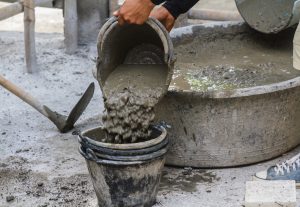The terms cement and concrete are often considered to be one in the same by many, but they aren’t. There is a difference, and it is a simple one: Concrete is made from a mix involving cement. It’s the fundamentals that define the difference between cement and concrete.

Cement vs. Concrete
Cement
Think of cement as the “glue.” It is what binds the concrete, using a variety of materials in cement, crushed and mixed with water. Currently, portland cement is the most commonly used because it has limestone in the compound. Limestone is largely available around the world and therefore is one of the cheapest materials to use. Throughout history, cement often included crushed rock with volcanic ash, burnt lime and brick.
To make cement, materials are extracted from a quarry by blasting, and then reduced in size. They are taken to plants for processing. Other materials such as sand and clay are ground in with the limestone at that time. The processed materials are heated in a kiln at above 2,600 degrees Fahrenheit, which causes structural changes to happen. New compounds are formed which will help with the strength of the cement.
In the final processing stage, cement is grounded into a fine powder. It is then available in various types, either for normal use, slower curing times, faster curing times and very slow curing times. Cements are tested for their strength and setting time.
At Quikspray we manufacture world leading cement mixing equipment. They’re available in different sizes, capacities and power configurations to meet a variety of needs, making them the most versatile mixers in the world. Check them out here:
Concrete
For concrete, mixes can vary, and that is largely based on strength and what it looks like. Concrete typically includes cement, the binder that holds it together; aggregates such as sand and rocks, water and admixtures such as slags, chemical retarders, accelerators and more.
When considering what type of concrete you need, think about whether you need it to have a high corrosion resistance. Will it be used for people to walk on? Park vehicles? Fill sanitary manholes?
Check out our guide on how to mix concrete!
Concrete is available in several forms, including ready mix — a popular choice. It is often delivered to a project site with water added in a barrel truck. It can be mixed on-site. Weather can play a factor and therefore admixtures are used.
The amount of water that is used to make concrete matters in terms of the strength. Less is more. Too much will mean weak cured concrete and too little will make it difficult to work with. It takes about 28 days for concrete to be done with curation and reach full strength. Curing has to be monitored, and concrete needs to be kept at above freezing temperatures during the process. Admixtures could include deicer to help with setting in colder temps.
Often, adding rebar or mesh will help concrete’s strength. It is placed before the concrete is poured to allow the concrete and steel to become one and more powerful together.
Steel rebar inside on concrete can corrode — carbon dioxide in the air reacts with cement to cause carbonation. Concrete that is less exposed to the air has a greater chance of staying clean of corrosion.
Wrapping Up
In terms of percentages, cement makes up about 10% to 15% of the total mass of concrete. Exact proportions are different in every mixture depending on the type of concrete being made. The sand and stone is held together by the cement.
If you’re still not fully clear on the difference between cement and concrete, think of it in a comparative way: Cement is like the flour in a cookie, or the sugar in a soda. It’s an ingredient, and the mixing is the most important part of what makes the concrete work for you.


